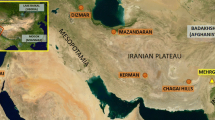Abstract
Differentiation of treated and non-treated gemstones is a chief concern for major jewellery import companies. Low-quality corundum specimens coming from Asia appear to be often treated with heat, BeO or flux in order to enhance their properties as precious minerals. A set of corundum samples, rubies and sapphires from different origins, both treated and non-treated has been analysed at the Centre Européen d’Archéométrie, with ion-beam-induced luminescence (IBIL) and other complementary techniques such as Raman, proton-induced X-ray emission (PIXE), and proton-induced gamma-ray emission (PIGE). IBIL, also known as ionoluminescence, has been used before to detect impurities or defects inside synthetic materials and natural minerals; its use for the discrimination of gemstone simulants or synthetic analogues has been elsewhere discussed (Cavenago-Bignami Moneta, Gemología, Tomo I Piedras preciosas, perlas, corales, marfil. Ediciones Omega, Barcelona, 1991). PIXE has been frequently applied in the archaeometric field for material characterisation and provenance studies of minerals (Hughes, Ruby & sapphire. RWH Publishing, Fallbrook, 1997; Calvo del Castillo et al., Anal Bioanal Chem 387:869–878, 2007; Calligaro et al., NIM-B 189:320–327, 2002) and PIGE complements the elemental analysis by detecting light elements in these materials such as—and lighter than—sodium that cannot be identified with the PIXE technique (Sanchez et al., NIM-B 130:682–686, 1997; Emmett et al., Gems Gemology 39:84–135, 2003). The micro-Raman technique has also been used complementarily to ion beam analysis techniques for mineral characterisation (Novak et al., Appl Surf Sci 231–232:917–920, 2004). The aim of this study is to provide new means for systematic analysis of corundum gemstone-quality mineral, alternative to the traditional gemmologic methods; for this purpose, a Spanish jewellery import company supplied us with a number of natural corundum samples coming from different places (part of them treated as explained above). The PIXE elemental concentrations of the samples showed large quantities of calcium and lead in some cases that can be linked to treatment with fluxes or lead oxide. The plot of the chromium and iron concentration grouped the samples in various aggregates that corresponded to the different types of corundum analysed. Micro-Raman complemented the PIXE analysis corroborating the presence of lead oxides but the use of the PIGE technique was not successful for the detection of beryllium due to the low cross section of the nuclear reaction chosen for its identification. IBIL was capable of distinguishing between treated and non-treated samples of the same type based on the luminescent features of the materials.













Similar content being viewed by others
Abbreviations
- IBIL:
-
ion-beam-induced luminescence
- IL:
-
ionoluminescence
- PIXE:
-
proton-induced X-ray emission
- PIGE:
-
proton-induced gamma-ray emission
- CEA-IPNAS:
-
Centre Européen d’Archéométrie—Institut de Physique Nucléaire Atomique et de Spectroscopie
- Ulg:
-
Université de Liège
- UAM:
-
Universidad Autónoma de Madrid
References
Cavenago-Bignami Moneta S (1991) Gemología, Tomo I Piedras preciosas, perlas, corales, marfil. Ediciones Omega, Barcelona (In Spanish)
Hughes RW (1997) Ruby & sapphire. RWH Publishing, Fallbrook http://www.ruby-sapphire.com (2008)
Calvo del Castillo H, Ruvalcaba JL, Calderón T (2007) Anal Bioanal Chem 387:869–878
Calligaro T, Colinart S, Poirot JP, Sudres C (2002) NIM-B 189:320–327
Sanchez JL, Osipowicz T, Tang SM, Tay TS, Win TT (1997) NIM-B 130:682–686
Emmett JL, Scarratt K, McClure SF, Moses T, Douthit TR, Hughes R, Novak S, Shigley JE, Wang W, Bordelon O, Kane RE (2003) Gems Gemology 39:84–135
Novak SW, Magee CW, Moses T, Wang W (2004) Appl Surf Sci 231–232:917–920
Archiwawanich S, Brack N, James BD, Liesegang J (2006) Appl Surf Sci 252:8646–8650
Osipowicz T, Tay TS, Orlic I, Tang SM, Watt F (1995) NIM-B 104:590–594
Calligaro T, Mossmann A, Poirot JP, Querré G (1998) NIM-B 136–138:846–850
Calligaro T, Poirot JP, Querré G (1999) NIM-B 150:628–634
Calligaro T, Dran JC, Poirot JP, Querré G, Salomon J, Zwaan JC (2000) NIM-B 161–163:769–774
Calvo del Castillo H, Millán A, Beneitez P, Ruvalcaba-Sil JL, Calderón T (2008) Rev Mex de Fisica 54(2):93–99
Agulló-López F, García G, Olivares J (2006) NIM-B 249:118–121
Dran JC, Salomon J, Calligaro T, Walter P (2004) NIM-B 219–220:7–15
Basun SA, Meltzer RS, Imbusch GF (2007) J Lum 125:31–39
Inouye A, Nagata S, Toh K, Tsuchiya B, Yamamoto S, Shikama T (2007) J Nucl Mats 367–370:1112–1116
Skurqtov SA, Jong Gun K, Stano J, Zagorski DL (2006) NIM-B 245:194–200
Acknowledgements
The authors would like to acknowledge Antonio Negueruela S.A. for providing the corundum samples for this work. Also to technicians A. Marchal, M. Philippe and A. Holsbeek for their support at the CEA-IPNAS cyclotron during the measurements and to technicians M. Clar and Said Rakkaa for their contribution to the development of the external trigger. The CEA-IPNAS research group would like to thank J. Salomon and L. Pichon for the measurements performed in the AGLAE. This project is supported by the Inter-university Attraction Pole Programme P6/16—Belgian State—Belgian Science Policy and the Spanish AECI programme no. A9332/07.
Author information
Authors and Affiliations
Corresponding author
Additional information
Work presented at the International Symposium on Luminescence Spectrometry 2008, September 7–11, Bologna, Italy
Rights and permissions
About this article
Cite this article
Calvo del Castillo, H., Deprez, N., Dupuis, T. et al. Towards the differentiation of non-treated and treated corundum minerals by ion-beam-induced luminescence and other complementary techniques. Anal Bioanal Chem 394, 1043–1058 (2009). https://doi.org/10.1007/s00216-009-2679-y
Received:
Revised:
Accepted:
Published:
Issue Date:
DOI: https://doi.org/10.1007/s00216-009-2679-y




